


Ammonium halates -- unstable compounds
Ammonium bromate and ammonium iodate both are unstable and rather energetic compounds, especially the bromate salt is very energetic. They can easily be prepared.
This is a fairly safe experiment, despite the fact that an explosive compound is made. The only important thing is that this experiment may not be scaled up. It is also important not to store ammonium bromate.
![]()
![]() Required
chemicals:
Required
chemicals:
-
iodic acid
-
ammonia (12% or better, it is important that the ammonia is clean and not full of detergents or other additives)
-
sodium bromate (potassium bromate is not suitable)
-
ammonium nitrate
![]() Required
equipment:
Required
equipment:
- petri dish
- test tube
- small burner, used for heating a test tube
![]() Safety:
Safety:
- Ammonia at a concentration of 12% is quite noxious. It has a strong pungent smell. Use adequate ventilation.
- Iodic acid is a strong and corrosive oxidizer, avoid contact with the skin.
- Sodium bromate is a strong oxidizer. Most likely, sodium bromate is a carcinogen as well, so avoid exposure to this chemical!
![]() Disposal:
Disposal:
- Let the test tubes with the decomposed material cool down and then rinse them with a dilute solution of sodium hydroxide, don't use ammonia for cleaning them! The waste may be flushed down the drain.
![]()
Preparation of ammonium bromate
Ammonium bromate can be prepared from sodium bromate and ammonium nitrate. Both solids dissolve in water very well, while ammonium bromate only dissolves moderately well. In a two-step crystallize/recrystallize process one can obtain ammonium bromate of good purity.
Unfortunately this process only works with sodium bromate. Potassium bromate does not dissolve very well in water and hence it is not suitable for making ammonium bromate.
![]() Take 1 ml of water and dissolve a gram or so of ammonium
nitrate in the water, such that a concentrated solution is obtained.
Take 1 ml of water and dissolve a gram or so of ammonium
nitrate in the water, such that a concentrated solution is obtained.
![]() Take
another 1 ml of water and dissolve a spatula full of sodium bromate in the water
(approximately 300 mg).
Take
another 1 ml of water and dissolve a spatula full of sodium bromate in the water
(approximately 300 mg).
![]() Mix the
two solutions. If a white solid is formed, then heat the liquid, until the
liquid is clear again.
Mix the
two solutions. If a white solid is formed, then heat the liquid, until the
liquid is clear again.
![]() Let the
liquid cool down. After a few hours there will be a thick layer of crystalline
solid at the bottom. This is impure ammonium bromate.
Let the
liquid cool down. After a few hours there will be a thick layer of crystalline
solid at the bottom. This is impure ammonium bromate.
![]() Decant
the clear liquid above the solid and put the solid on a piece of folded paper
tissue. This can be done by tapping the test tube on the paper tissue, until all
of the solid is on the paper tissue. Due to capillary effects, the paper absorbs
most of the liquid, which still sticks to the solid.
Decant
the clear liquid above the solid and put the solid on a piece of folded paper
tissue. This can be done by tapping the test tube on the paper tissue, until all
of the solid is on the paper tissue. Due to capillary effects, the paper absorbs
most of the liquid, which still sticks to the solid.
![]() Carefully scrape the solid from the paper tissue, assuring that no paper is
scraped off. Put the solid in a test tube and add half a ml of water. Heat the
liquid, until most of the solid has dissolved. Add water drop by drop, in the
meantime keeping the liquid hot, until all of the solid has dissolved.
Carefully scrape the solid from the paper tissue, assuring that no paper is
scraped off. Put the solid in a test tube and add half a ml of water. Heat the
liquid, until most of the solid has dissolved. Add water drop by drop, in the
meantime keeping the liquid hot, until all of the solid has dissolved.
![]() Let the
liquid cool down again. After a few hours again a crop of crystals will have
formed at the bottom. This is almost pure ammonium bromate.
Let the
liquid cool down again. After a few hours again a crop of crystals will have
formed at the bottom. This is almost pure ammonium bromate.
![]() Again
decant the liquid and put the solid on a piece of paper tissue. Once most of the
liquid is absorbed by the paper, carefully scrape the solid from the paper and
put it on a petri dish and spread a little bit. Put the solid in a dry warm
place (e.g. on a heating radiator). After a few hours a perfectly dry white
crystalline solid is obtained. The yield will be a few hundreds of mg of solid.
Again
decant the liquid and put the solid on a piece of paper tissue. Once most of the
liquid is absorbed by the paper, carefully scrape the solid from the paper and
put it on a petri dish and spread a little bit. Put the solid in a dry warm
place (e.g. on a heating radiator). After a few hours a perfectly dry white
crystalline solid is obtained. The yield will be a few hundreds of mg of solid.
![]() Scrape
the solid from the glass and put it in a small tightly closed container for
further experimenting. According to some literature it may decompose
spontaneously, so do not keep this solid around for a long time, use all of it
in subsequent experiments within one day of preparation and in the meantime
store the small vial with the ammonium bromate in a glass jar with a loosely
tightened metal screw cap, just to be sure that in the case of accidental
premature decomposition nothing serious can happen.
Scrape
the solid from the glass and put it in a small tightly closed container for
further experimenting. According to some literature it may decompose
spontaneously, so do not keep this solid around for a long time, use all of it
in subsequent experiments within one day of preparation and in the meantime
store the small vial with the ammonium bromate in a glass jar with a loosely
tightened metal screw cap, just to be sure that in the case of accidental
premature decomposition nothing serious can happen.
Heating of the solid ammonium bromate
Put a small amount of the ammonium bromate in a test tube and heat the test tube above the flame of an alcohol burner or a small bunsen burner. After a few seconds a fairly loud pop/whoop sound is produced, a brief flash of orange light is produced and then the solid has decomposed, one of the decomposition products being bromine. It is not a true explosion, but it is close to it. Most remarkable is that the entire test tube is filled with the light of an orange flash for a short time (at most 30 ms). Below, 4 pictures show the sequence of events, just before the decomposition, the flash of orange light and just after the decomposition. Time between two pictures is 33 ms. It also is nice to see that immediately after the flash of light the resulting bromine is higher up in the test tube and more dilute than 33 ms later. This is due to the heat, in which the gas mix expands and which quickly contracts on cooling down.
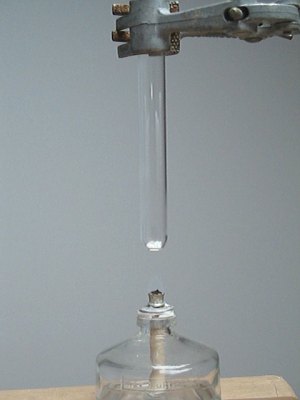
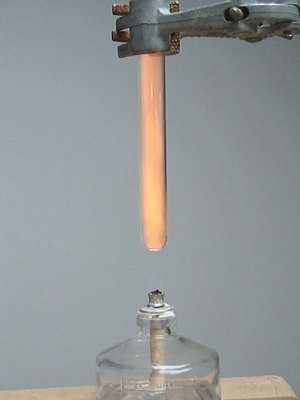
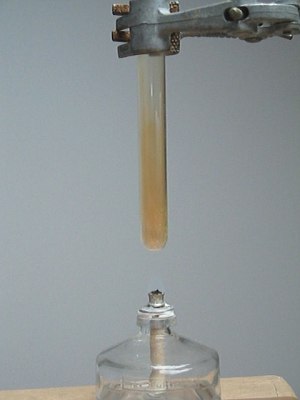
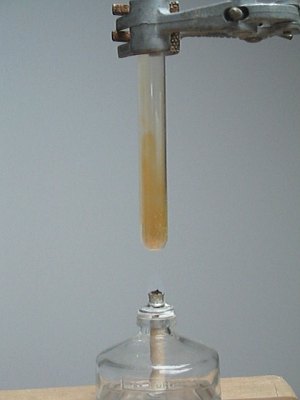
The same experiment was repeated in a dimly lit room, just to get a better impression of the flash of light. The result of this experiment is shown in the four pictures below, which again were taken at a frame rate of 30 frames per second.
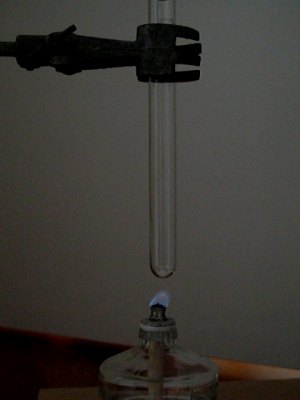
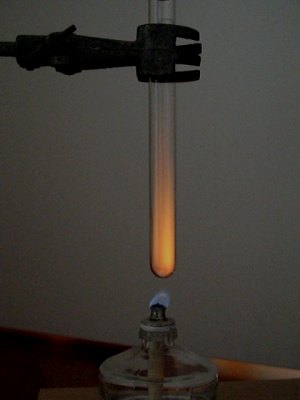
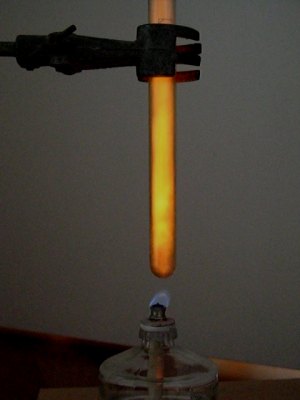
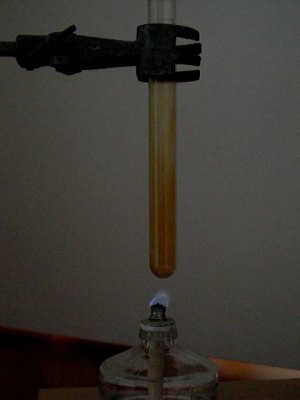
The four pictures nicely show that the entire test tube is filled with a fairly bright orange light. Most remarkable is that the light is spread throughout the entire test tube.
Another observation made in the experiments with ammonium bromate is that no really high temperature is needed for ignition of the solid. Just a few seconds after the flame is put below the test tube, the solid decomposes and only a few seconds after the decomposition one can touch the test tube again without getting burnt skin. The precise ignition temperature was not measured, but it is expected not to be far above 100 °C.
Immediately after the decomposition, one can also observe a very thin white smoke above the test tube, and the smell of bromine can be observed. The white smoke most likely is ammonium bromide, possibly contaminated with some unreacted ammonium bromate.
![]()
Preparation of ammonium iodate
Preparation of ammonium iodate is very simple, when one has access to iodic acid. One simply has to add excess ammonia to a solution of iodic acid.
![]() Dissolve a spatula full of iodic acid in half a ml
of water.
Dissolve a spatula full of iodic acid in half a ml
of water.
![]() Add one ml of 12% clean ammonia. Assure that excess ammonia
is added. After mixing the liquid should still have a smell of ammonia.
Add one ml of 12% clean ammonia. Assure that excess ammonia
is added. After mixing the liquid should still have a smell of ammonia.
When the ammonia is added, then a very fine crystalline precipitate is formed. For convenience, it is best to add the liquids to each other in a petri dish and not in a test tube. The precipitate has a tendency to stick to the glass and this is rather annoying, when this is inside a test tube. Mix the liquids with each other with a small plastic spatula (don't use metal) or a glass rod.
![]() After mixing, spread the liquid with the precipitate over the
petri dish and put the petri dish in a dry and warm place (e.g. on a heat radiator at 50
ºC or so).
After mixing, spread the liquid with the precipitate over the
petri dish and put the petri dish in a dry and warm place (e.g. on a heat radiator at 50
ºC or so).
After one day, the material is dry and has no smell of ammonia anymore.
Heating of the solid ammonium iodate
Put a small amount of the ammonium iodate in a test tube and heat the test tube above the flame of an alcohol burner or a small bunsen burner. For a while, nothing seems to happen, but at a certain moment a strong hissing noise is produced and the solid decomposes. Black/grey crystals of iodine are deposited on the cooler parts of the test tube and purple vapor of iodine can be observed.
The decomposition of ammonium iodate is not as violent as the decomposition of ammonium bromate, but still it is quite violent. No light is produced in the decomposition reaction and it also takes longer before the reaction sets off. The temperature of ignition is higher. The four pictures below show the onset of decomposition and the total decomposition. Complete decomposition is reached in 60 ms or so.
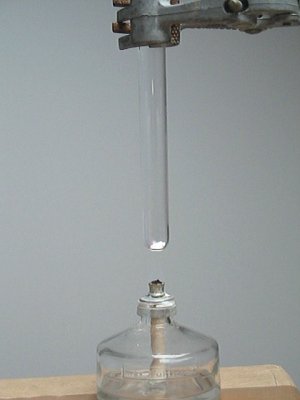
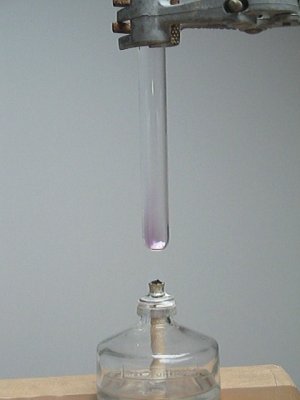
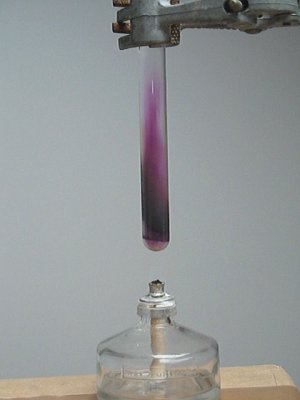
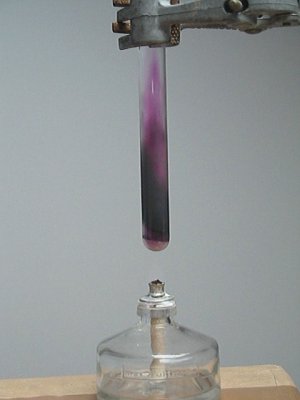
No gas, smoke or vapor escapes the test tube, all of the iodine settles at the glass as a black/grey crystalline solid.
![]()
Videos of decomposition reactions
Videos with audio were made of both decomposition reactions. The bromate reaction is filmed in diffuse daylight and in a dimly lit room, the iodate reaction is filmed in daylight. All three videos can be downloaded here:
- decomposition of ammonium bromate, filmed in daylight
- decomposition of ammonium bromate, filmed in dimly lit room
- decomposition of ammonium iodate, filmed in daylight
Download sizes are approximately 500 kByte, 850 kByte and 400 kByte.
![]()
Discussion of results
![]() Although ammonium ion is very reluctant to oxidation in aqueous solution, it is
more easily oxidized in the solid state at elevated temperature.
Both ammonium bromate and ammonium iodate easily
exhibit an internal oxidation/reduction reaction. They have their own fuel and own
oxidizer in one compound. The ammonium ion serves as fuel, the bromate (iodate)
ion serves as oxidizer.
Although ammonium ion is very reluctant to oxidation in aqueous solution, it is
more easily oxidized in the solid state at elevated temperature.
Both ammonium bromate and ammonium iodate easily
exhibit an internal oxidation/reduction reaction. They have their own fuel and own
oxidizer in one compound. The ammonium ion serves as fuel, the bromate (iodate)
ion serves as oxidizer.
When the solids decompose, the following main reactions occurs (without doubt there will be numerous side reactions):
2NH4BrO3(s) → N2(g) + 4H2O(g) + Br2(g) + O2(g)
2NH4IO3(s) → N2(g) + 4H2O(g) + I2(s, g) + O2(g)
Especially in the experiment with the ammonium bromate, one can also nicely see that water is formed. After the reaction, the inside of the test tube is wet. This cannot easily be seen on the pictures and videos, but if the experiment is done and the test tube is inspected after the reaction, then one can nicely see that it is wet inside.
![]() One possible side reaction is the reaction in which halide ion is formed. This
most likely explains the presence of a thin white smoke in the decomposition of
ammonium bromate. The bromide ion can form NH4Br which appears as
thin white smoke. This side reaction, however, does not occur at a large extent.
The white smoke is very thin (hardly visible) and there is a lot of bromine
vapor in the test tube.
One possible side reaction is the reaction in which halide ion is formed. This
most likely explains the presence of a thin white smoke in the decomposition of
ammonium bromate. The bromide ion can form NH4Br which appears as
thin white smoke. This side reaction, however, does not occur at a large extent.
The white smoke is very thin (hardly visible) and there is a lot of bromine
vapor in the test tube.